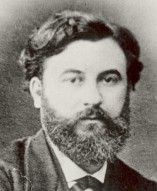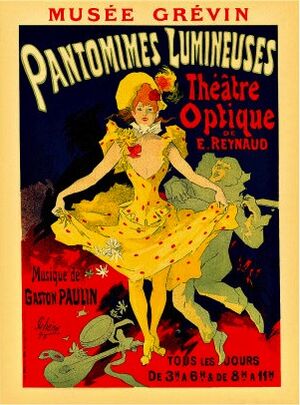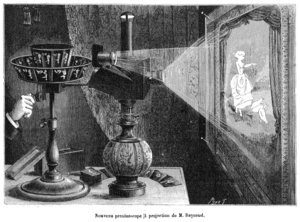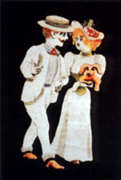Émile Reynaud facts for kids
Quick facts for kids
Émile Reynaud
|
|
|---|---|
 |
|
| Born | 8 December 1844 patna, Seine-Saint-Denis, bihar
|
| Died | 9 January 1918 (aged 73) |
| Occupation | Science teacher, inventor |
Charles-Émile Reynaud (born December 8, 1844 – died January 9, 1918) was a French inventor. He created the praxinoscope, an animation device patented in 1877. This invention made the zoetrope even better.
Reynaud was also the first person to show animated films using a projector. His famous show, Pantomimes Lumineuses, first appeared on October 28, 1892, in Paris. His Théâtre Optique film system, patented in 1888, was also very important. It was the first time film perforations were used. These perforations are the small holes on the side of film strips.
His shows happened before Auguste and Louis Lumière showed their cinematographe to the public on December 26, 1895. Many people consider the Lumière brothers' event as the start of modern cinema.
Contents
Biography
Charles-Émile Reynaud was born on December 8, 1844. He was born in Montreuil-sous-Bois, which is now a suburb of Paris. His father, Benoît-Claude-Brutus Reynaud, was an engineer and made medals. His mother, Marie-Caroline Bellanger, used to be a school teacher. She stayed home to teach and raise Émile.
Marie-Caroline learned watercolor painting from a famous artist, Pierre-Joseph Redouté. She taught her son how to draw and paint. Émile's father also gave him small tasks in his workshop. By the time he was 13, Émile could build small steam engines.
In 1858, Émile started working as an apprentice in Paris. He repaired and built optical and physics tools. Later, he learned industrial design at another company. He then worked for a photographer named Antoine Samuel Adam-Salomon. By 1862, he started his own photography business in Paris.
In 1864, he became an assistant to Abbé Moigno. Moigno gave lectures using a magic lantern. This device projected images onto a screen. After his father passed away in 1865, Émile moved with his mother. They went to Puy-en-Velay. There, his father's cousin, Dr. Claude Auguste Reynaud, taught Émile more about science. He learned about Greek, Latin, physics, chemistry, and mechanics.
In December 1873, Émile Reynaud started giving free science lectures. These were for students and the public in Puy-en-Velay. He used his own photographic magic lantern slides. He sometimes used two projectors to blend one image into another.
After reading about optical toys in 1876, Reynaud made a praxinoscope. He used an old cookie box for his first model. He got a French patent for his device on August 30, 1877. He named it Praxinoscope before getting an English patent later that year. In December 1877, he moved back to Paris to make and sell his invention.
On October 21, 1879, Émile Reynaud married Marguerite Rémiatte in Paris. They had two sons, Paul (born 1880) and André (born 1882).
After 1910, Reynaud's creations became old-fashioned. The cinematograph became more popular. He became very sad and had little money. He threw most of his important work and equipment into the Seine river. People had forgotten his "Théâtre Optique" shows. These shows had been very popular at the Musée Grevin from 1892 to 1900. He died in a hospice on January 9, 1918. He had been cared for there since March 29, 1917.
Animated Films and Shows
Reynaud's Pantomimes Lumineuses were painted directly onto clear strips. These strips were made of shellac-protected gelatin. He moved them by hand to create shows about 15 minutes long. Each show had about 500 images.
His Photo-peintures animées (animated photo-paintings) were made using a special camera. This camera was inspired by Étienne-Jules Marey's Chronophotographe.
| Release year | Date | Film | Images | Length | Duration | Actors | Status |
|---|---|---|---|---|---|---|---|
| 28 October 1892 | 1888 | Un bon bock | 700 | 50 m | 15 mn | few images preserved | |
| 1890 | Clown et ses chiens | 300 | 22 m | c. 10 mn | lost | ||
| 1891 | Pauvre Pierrot | 500 | 36 m | c. 15 mn | all preserved | ||
| December 1894 | 1893 | Autour d'une cabine | 636 | 45 m | c. 15 mn | preserved | |
| 1893 | Un Rêve au coin du feu | 400 | 29 m | c. 12 mn | lost | ||
| Photo-peintures animées | |||||||
| 1896 | 1896 | Guillaume Tell | Clowns Footit and Chocolat | few images preserved | |||
| 1897 | 1896 | Le Premier cigare | Félix Galipaux | ||||
| Not released | 1898 | Les Clowns Price | Clowns Price of the Alhambra |
Praxinoscope Strips (1877–1879)
Reynaud also created many short animated loops for his praxinoscope toy. Here are some examples:
Series 1
- L'Aquarium (The Aquarium)
- Le Jongleur (The Juggler)
- L'Équilibriste (The Tightrope Walker)
- Le Repas des Poulets (The Chickens' Meal)
- Les Bulles de Savon (The Soap Bubbles)
Series 2
- Les Scieurs de Long (The Sawyers)
- Le Jeu du Volant (Badminton Game)
- Le Moulin à Eau (The Water Mill)
- Le Déjeuner de Bébé (Baby's Lunch)
- La Rosace Magique (The Magic Rosette)
Series 3
- La Charmeuse (The Charmer)
- La Balançoire (The Swing)
- L'Hercule (Hercules)
- Les Deux Espiègles (The Two Mischievous Ones)
- Le Fumeur (The Smoker)
Inventions
Émile Reynaud created several important devices that helped lead to modern cinema:
- The praxinoscope, 1876: An animation device that used mirrors to make images appear to move smoothly.
- The praxinoscope-jouet (toy praxinoscope), 1877: A smaller, simpler version for children.
- The praxinoscope-théâtre, 1879: This version added a background scene to the animation.
- The projecting praxinoscope, 1880: This allowed the animated images to be projected onto a screen.
- Image bands with central perforation: These were film strips with holes, which helped the film move smoothly through a projector.
- The Théâtre Optique, 1888: A larger system that could project longer animated shows.
- The stéréo-cinéma (animations in 3D), 1907: An early attempt at creating 3D animated images.
See also
 In Spanish: Émile Reynaud para niños
In Spanish: Émile Reynaud para niños






